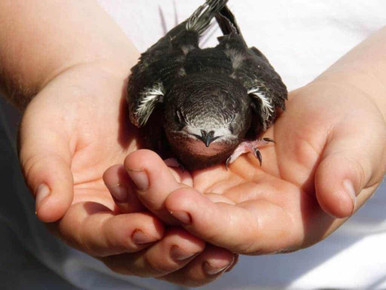The Kennedy Wild Bird Food Guide to the Common Swift
The common swift bird (scientific name Apus Apus) is one of the UK’s most skilled fliers, and if you’re lucky enough to spot one it will be in a flash. This medium-sized bird darts around very quickly with its long, sharp wings and forked tail (both of which help with its aerial agility). The swift bird speed can reach as high as 111.6km/h (69.3mph) which is extremely speedy. In our Kennedy Wild Bird Food Guide, you’ll discover all you need to know about this incredibly speedy customer. From common swift facts to their diet, here’s everything you need to know.What do common swifts look like?
Common swifts are almost entirely blackish-brown, except for small white or grey patches on their chins (although this isn’t really visible from afar). It’s often said that the common swift resembles a boomerang, because they have a short forked tail and, in contrast, long stretched out wings. If you spot a boomerang-looking bird in the sky, it might just be a common swift! In terms of gendered appearance, common swifts are a sexually monomorphic species which means that there is no differentiation between male and female. They both look alike!
What do common swifts eat?
Common swift food revolves around a range of aerial critters, including airborne spiders and flies. Swifts feed at heights of between 50-100m although they are often drawn to lower levels if the weather is harsher than usual. Swifts have a somewhat unusual way of feeding. Generally regarded as opportunistic feeders, swifts will often go after swarms and hatchlings and are very selective with what they take. They also avoid stinging insects. Once their prey is captured, swifts collect insects at the back of their throat (in a special food pouch!) which they then bind with saliva until it resembles a ball (this is called a ‘bolus’). Boluses are either eaten (snacked on periodically) or taken back to their nest. A bolus can contain thousands of insects! Our suet pellets for birds are perfect for swifts.Breeding habits and behaviour of common swifts
Common swifts come to maturation around four years old, and the birds that survive the early years can expect to live another four to six years. Given their supreme flying skills (they really are masters of the sky), swifts have very few predators. If a potential predator got close, a swift could evade them easily. The interesting thing about a swift’s breeding habits is that they pair for life, meeting up each and every spring at the same nest. They usually lay around 2-3 eggs at 2-3 day intervals.The swift bird nest and nesting habits
Swifts’ nests are usually quite high up, under the eaves of old houses (and churches too). One of the most extraordinary things about common swifts is that the division of labour is split equally between males and females. Usually, with most other birdlife, the female builds the nest while the male hunts for food.What does the common swift call sound like?
The common swift call is unlike other bird calls you may have heard. It comes in two different pitches, and sounds more like a loud scream than a traditional ‘bird song’. It can be quite jarring! The female screams higher. Have a listen to the clip below to hear the call/scream for yourself!Where to find the common swift in the UK
Each spring, around 90,000 pairs of swifts make their gruelling 6,000-mile journey from Africa. They can be found in both urban and suburban spaces across the whole of England and Ireland (as well as parts of East Scotland, on the coast). Wherever there are old houses with eaves and wide gutters!Common swift facts
- Swifts are known for forming ‘screaming parties’ during summer nights. 10-20 swifts congregate in flight near their nesting area. They even call out for other swifts to come and join! Late in the breeding season, even bigger screaming parties occur and at higher altitudes.
- Swifts spend their lives in the air, except for when they’re nesting. They live on insects caught in-flight, and drink on the wing (skimming the surface for refreshment). They also mate and sleep on the wing! Some swifts can go as long as 10 months without ever landing.
- Many swifts play ‘dead’ as an adaptive defence mechanism (even though they have very few predators). This is called thanatosis, and is seen in animals from snakes and spiders to ants and frogs.
- Come wintertime, swifts go in search of warm sunny weather in places like Malawi, Tanzania, Zimbabwe, and South Africa.
- Swifts have some of the smallest feet of all birdlife, and almost no legs. This contributes to their flying skills, making them streamlined.
